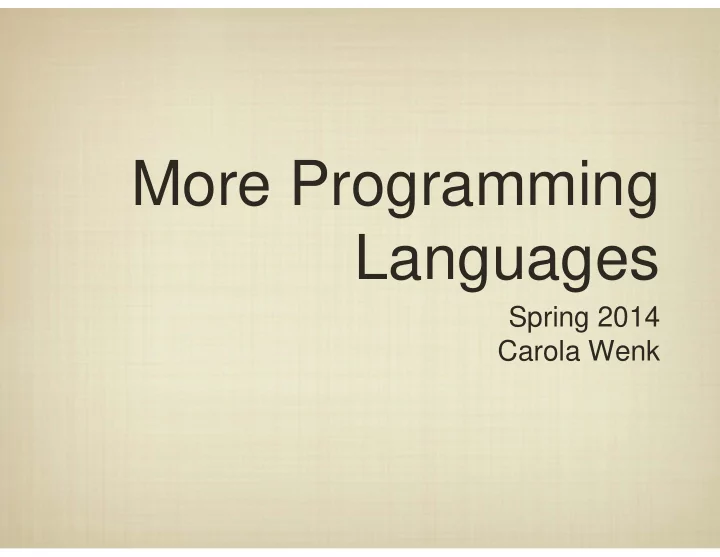

More Programming Languages Spring 2014 Carola Wenk
Web Scripting We’ve seen how (relatively) easy it is to create a new • language. This suggests that languages can actually be application-specific. Let’s take a look at a web page: • helloworld.html <html> <head> <title>Hello World title</title> </head> <body> <p>Hello World in html</p> </body> </html> How is this web page “executed”?
Web Scripting We’ve seen how (relatively) easy it is to create a new • language. This suggests that languages can actually be application-specific. Let’s take a look at a web page: • helloworld.html <html> <head> <title>Hello World title</title> </head> HTML Browser <body> <p>Hello World in html</p> </body> </html> Like any other program, it must be parsed and transformed into machine instructions (that display things). But these pages are static, what if we want them to execute code?
PHP Scripting helloworld.php <html> <head> <title>PHP Test</title> </head> <body> <?php echo '<p>Hello World in php</p>'; ?> </body> </html> PHP stands for “PHP: Hypertext Preprocessor”; this scripting language can be embedded into HTML code, and allows us to dynamically generate a page upon execution, possibly pulling information from a database answering a query from the user..
PHP Scripting PHP Interpreter (on a web server) helloworld.php <html> <head> <title>PHP Test</title> </head> <body> <?php echo '<p>Hello World in php</p>'; ?> HTML Browser </body> </html> PHP stands for “PHP: Hypertext Preprocessor”; PHP code can be embedded into HTML code, and allows us to dynamically generate a page upon execution. PHP is a full-featured programming language whose syntax is similar to C/Java.
Forms and Input PHP Interpreter helloworldForm.php (on a web server) <html> <head> <title>PHP Test: Hello World form</title> </head> <body> <?php HTML Browser echo '<p>Hello World with form</p>'; ?> <form name="form" action="" method="get"> <input type="text" name="subject" id="subject" value=""> </form> <?php echo $_GET['subject']; ?> </body> </html>
Javascript Javascript Interpreter helloworldJS.html <html> <head> <title>Javascript Test</title> </head> <body> <script type="text/javascript"> document.write(‘Hello World in javascript!’); HTML Browser </script> </body> </html> JavaScript is embedded into an HTML page in the same way as PHP.
Embedded Devices Embedded devices often have their own operating systems - how are applications implemented?
History of Java While we have been using it as a general-purpose language, Java • was originally developed by James Gosling at Sun Microsystems in the early 1990s. Java is deployed on 3 billion devices. Is Java compiled or • interpreted? Is it more or less “portable” than C?
Android The core operating system functions in an Android device are derived from Linux.
Java API for Android • While there could have been a specific language for Android, Java provides a large set of libraries that can be leveraged. • So, Android applications simply look like the Java programs we’ve seen. • These programs are converted into machine instructions using a chip-specific compiler.
iOS (iPhone, iPad, iPod) The core operating system functions in an “iOS” device are derived from OSX, which is itself derived from BSD (Unix).
UNIX is Everywhere
Objective C
iOS Apple utilizes Objective C as the language of choice for iOS • apps. Objective C is an interesting extension to the C language that • implements features of SmallTalk. #import <stdio.h> int main( int argc, const char *argv[] ) { printf( "hello world\n" ); return 0; } The C features are familiar, but the object-oriented programming model is somewhat unorthodox.
Objective C MyClass.m #import "MyClass.h" #import <stdio.h> MyClass.h @implementation MyClass #import <Foundation/NSObject.h> -(id) init { count += 1; @interface MyClass: NSObject { return self; @private } -int a; @public -(void) print { -int b; printf( "%i\n",a); +int count; } } -(void) set_a: (int) n { -(void) print; a = n; -(void) set_a: (int) n; } +(int) count; @end +(int) count { return count; + : Static } @end - : Instance
C++ vs. Objective C #import <stdio.h> #import "MyClass.h" #include <stdio.h> #include "MyClass.h" int main(int argc, const char *argv[] ) { // create a new instance int main(int argc, const char *argv[] ) { MyClass *x = [[MyClass alloc] init]; // create a new instance MyClass *x = new MyClass(); // set the values [x set_a: 1]; // set the values x.set_a(1); // print it printf( "x is: " ); // print it [x print]; printf("x is: %d\n", x.get_a()); printf( "\n" ); // free memory free(x); // free memory [x release]; return 0; } return 0; } Objective C essentially replaces the membership operators ( . , -> ) and uses “messages” to class members.
Objective C
Recommend
More recommend